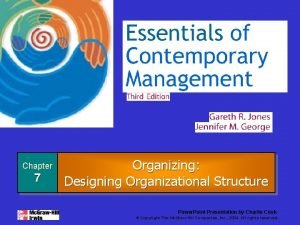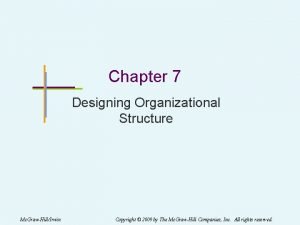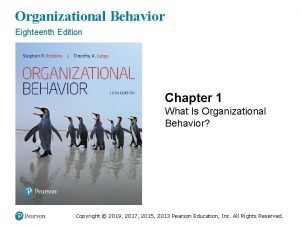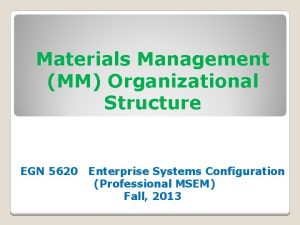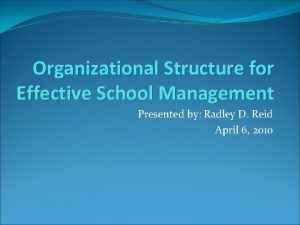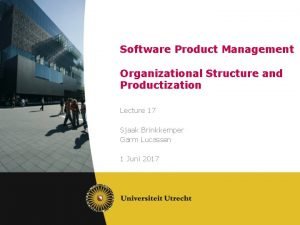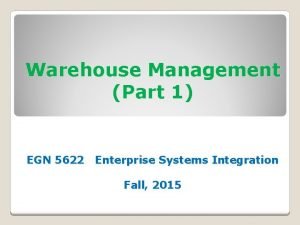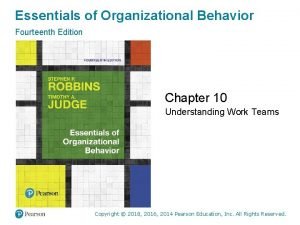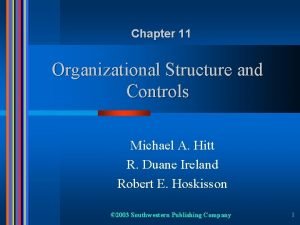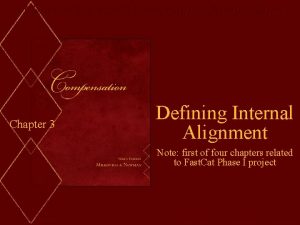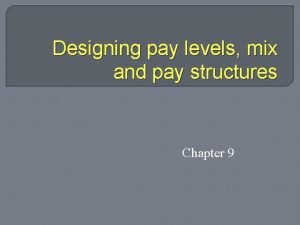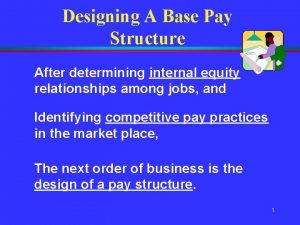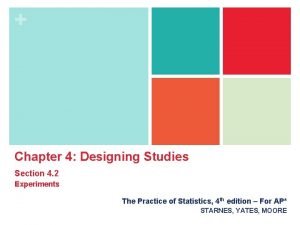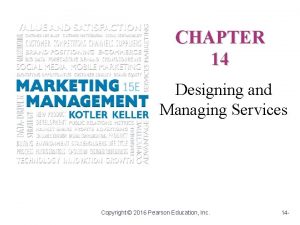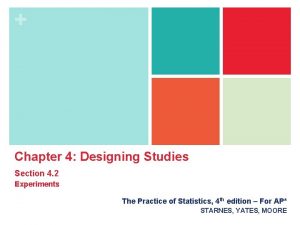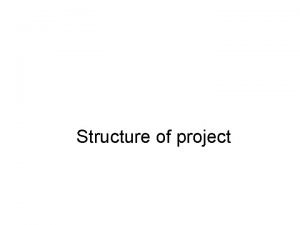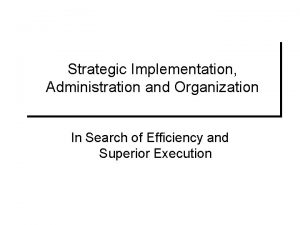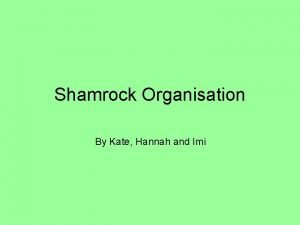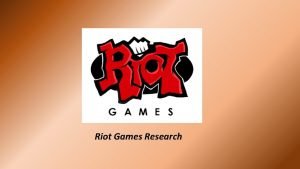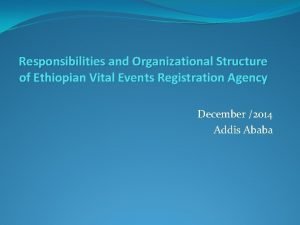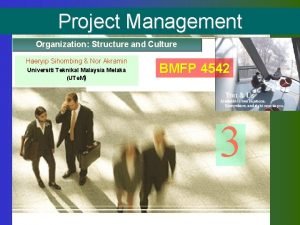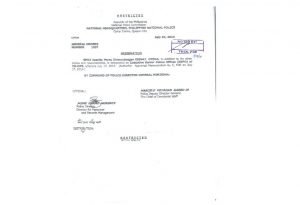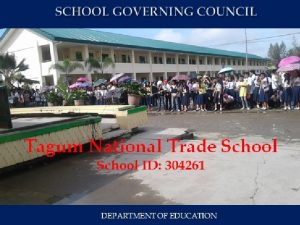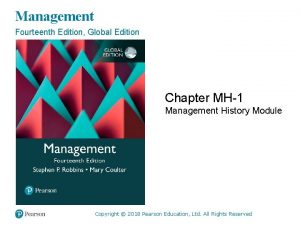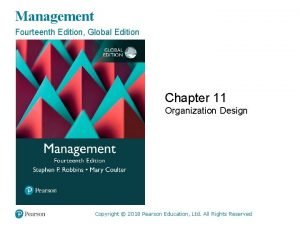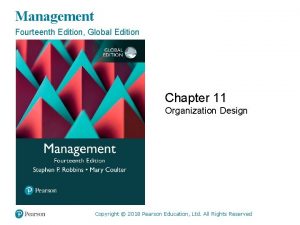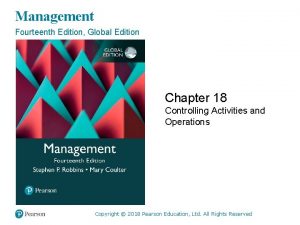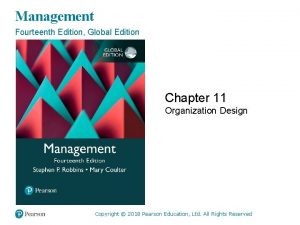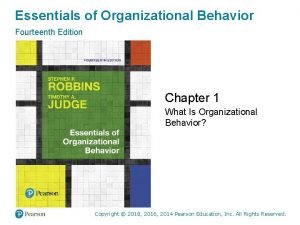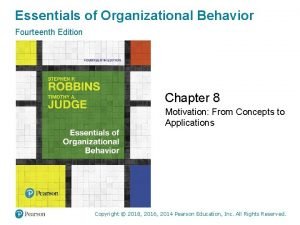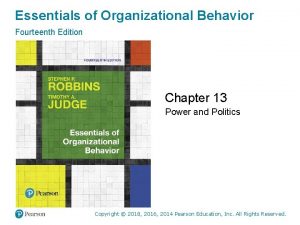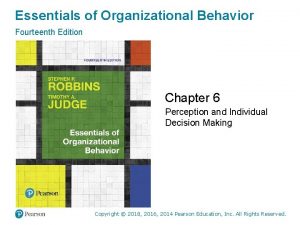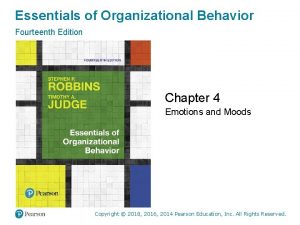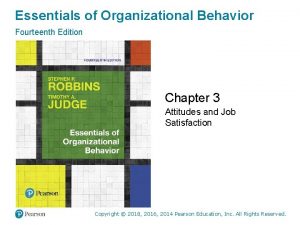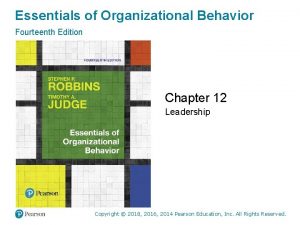Management Fourteenth Edition Chapter 11 Designing Organizational Structure





































- Slides: 37

Management Fourteenth Edition Chapter 11 Designing Organizational Structure Copyright © 2018, 2016, 2014 Pearson Education, Inc. All Rights Reserved

Elements of Organizational Design • Organizing: management function that involves arranging and structuring work to accomplish the organization’s goals • Organizational structure: the formal arrangement of jobs within an organization • Organizational chart: the visual representation of an organization’s structure • Organizational design: creating or changing an organization’s structure Copyright © 2018, 2016, 2014 Pearson Education, Inc. All Rights Reserved

Exhibit 11 -1 Purposes of Organizing Purposes Divides work to be done into specific jobs and departments. Assigns tasks and responsibilities associated with individual jobs. Coordinates diverse organizational tasks. Clusters jobs into units. Establishes relationships among individuals, groups, and departments. Establishes formal lines of authority. Allocates and deploys organizational resources. Copyright © 2018, 2016, 2014 Pearson Education, Inc. All Rights Reserved

Work Specialization • Work specialization: dividing work activities into separate job tasks Copyright © 2018, 2016, 2014 Pearson Education, Inc. All Rights Reserved

Exhibit 11 -2 Economies and Diseconomies of Work Specialization Exhibit 11 -2 shows the economies and diseconomies of work specialization. Copyright © 2018, 2016, 2014 Pearson Education, Inc. All Rights Reserved

Departmentalization • Departmentalization: the basis by which jobs are grouped together Copyright © 2018, 2016, 2014 Pearson Education, Inc. All Rights Reserved

Exhibit 11 -3 The Five Common Forms of Departmentalization (1 of 3) Exhibit 11 -3 illustrates each type of departmentalization as well as the advantages and disadvantages of each. Copyright © 2018, 2016, 2014 Pearson Education, Inc. All Rights Reserved

Exhibit 11 -3 The Five Common Forms of Departmentalization (2 of 3) Exhibit 11 -3 illustrates each type of departmentalization as well as the advantages and disadvantages of each. Copyright © 2018, 2016, 2014 Pearson Education, Inc. All Rights Reserved

Exhibit 11 -3 The Five Common Forms of Departmentalization (3 of 3) Exhibit 11 -3 illustrates each type of departmentalization as well as the advantages and disadvantages of each. Copyright © 2018, 2016, 2014 Pearson Education, Inc. All Rights Reserved

Cross-Functional Team • Cross-functional team: a work team composed of individuals from various functional specialties Copyright © 2018, 2016, 2014 Pearson Education, Inc. All Rights Reserved

Chain of Command • Chain of command: the line of authority extending from upper organizational levels to the lowest levels, which clarifies who reports to whom Copyright © 2018, 2016, 2014 Pearson Education, Inc. All Rights Reserved

Authority • Authority: the line of authority extending from upper organizational levels to the lowest levels, which clarifies who reports to whom • Line authority: authority that entitles a manager to direct the work of an employee • Staff authority: positions with some authority that have been created to support, assist, and advise those holding line authority Copyright © 2018, 2016, 2014 Pearson Education, Inc. All Rights Reserved

Responsibility • Responsibility: the obligation or expectation to perform any assigned duties • Unity of command: the management principle that each person should report to only one manager Copyright © 2018, 2016, 2014 Pearson Education, Inc. All Rights Reserved

Span of Control • Span of control: the number of employees a manager can efficiently and effectively manage Copyright © 2018, 2016, 2014 Pearson Education, Inc. All Rights Reserved

Exhibit 11 -4 Contrasting Spans of Controls As Exhibit 11 -4 shows, if one organization has a span of four and the other a span of eight, the organization with the wider span will have two fewer levels and approximately 800 fewer managers. Copyright © 2018, 2016, 2014 Pearson Education, Inc. All Rights Reserved

Centralization and Decentralization • Centralization: the degree to which decision making is concentrated at upper levels of the organization • Decentralization: the degree to which lower-level employees provide input or actually make decisions Copyright © 2018, 2016, 2014 Pearson Education, Inc. All Rights Reserved

Exhibit 11 -5 Centralization or Decentralization More Centralization More Decentralization Environment is stable. Environment is complex, uncertain. Lower-level managers are not as capable or experienced at making decisions as upper-level managers. Lower-level managers are capable and experienced at making decisions. Lower-level managers do not want a say in decisions. Lower-level managers want a voice in decisions. Decisions are relatively minor. Decisions are significant. Organization is facing a crisis or the risk of Corporate culture is open to allowing company failure. managers a say in what happens. Company is large. Company is geographically dispersed. Effective implementation of company strategies depends on managers retaining strategies depends on managers having say over what happens. involvement and flexibility to make decisions. Copyright © 2018, 2016, 2014 Pearson Education, Inc. All Rights Reserved

Employee Empowerment • Employee empowerment: giving employees more authority (power) to make decisions Copyright © 2018, 2016, 2014 Pearson Education, Inc. All Rights Reserved

Formalization • Formalization: how standardized an organization’s jobs are and the extent to which employee behavior is guided by rules and procedures Copyright © 2018, 2016, 2014 Pearson Education, Inc. All Rights Reserved

Mechanistic and Organic Structures • Mechanistic organization: an organizational design that’s rigid and tightly controlled • Organic organization: an organizational design that’s highly adaptive and flexible Copyright © 2018, 2016, 2014 Pearson Education, Inc. All Rights Reserved

Exhibit 11 -6 Mechanistic Versus Organic Organizations Mechanistic Organic High specialization Cross-functional teams Rigid departmentalization Cross-hierarchical teams Clear chain of command Free flow of information Narrow spans of control Wide spans of control Centralization Decentralization High formalization Low formalization Copyright © 2018, 2016, 2014 Pearson Education, Inc. All Rights Reserved

Strategy and Structure • An organization’s structure should facilitate goal achievement. Because goals are an important part of the organization’s strategies, it’s only logical that strategy and structure are closely linked. Copyright © 2018, 2016, 2014 Pearson Education, Inc. All Rights Reserved

Size and Structure • There’s considerable evidence that an organization’s size affects its structure, but once an organization grows past a certain size, size has less influence on structure. Copyright © 2018, 2016, 2014 Pearson Education, Inc. All Rights Reserved

Technology and Structure • Unit production: the production of items in units or small batches • Mass production: the production of items in large batches • Process production: the production of items in continuous processes Copyright © 2018, 2016, 2014 Pearson Education, Inc. All Rights Reserved

Exhibit 11 -7 Mechanistic Versus Organic Organizations blank Unit Production Mass Production Process Production Structural characteristics: Low vertical differentiation Moderate vertical differentiation High vertical differentiation blank Low horizontal differentiation High horizontal differentiation Low horizontal differentiation blank Low formalization High formalization Low formalization Most effective structure: Organic Mechanistic Organic Copyright © 2018, 2016, 2014 Pearson Education, Inc. All Rights Reserved

Environmental Uncertainty and Structure • In stable and simple environments, mechanistic designs can be more effective. • The greater the uncertainty, the more an organization needs the flexibility of an organic design. Copyright © 2018, 2016, 2014 Pearson Education, Inc. All Rights Reserved

Traditional Organizational Design Options • Simple structure: an organizational design with little departmentalization, wide spans of control, centralized authority, and little formalization • Functional structure: an organizational design that groups together similar or related occupational specialties • Divisional structure: an organizational structure made up of separate, semiautonomous units or divisions Copyright © 2018, 2016, 2014 Pearson Education, Inc. All Rights Reserved

Exhibit 11 -8 Traditional Organizational Designs A summary of the strengths and weaknesses of each type of organizational design can be found in Exhibit 11 -8. Copyright © 2018, 2016, 2014 Pearson Education, Inc. All Rights Reserved

Team Structures • Team structure: an organizational structure in which the entire organization is made up of work teams Copyright © 2018, 2016, 2014 Pearson Education, Inc. All Rights Reserved

Matrix and Project Structures • Matrix structure: an organizational structure that assigns specialists from different functional departments to work on one or more projects • Project structure: an organizational structure in which employees continuously work on projects Copyright © 2018, 2016, 2014 Pearson Education, Inc. All Rights Reserved

Exhibit 11 -9 Example of a Matrix Organization Exhibit 11 -9 shows an example of a matrix organization. Copyright © 2018, 2016, 2014 Pearson Education, Inc. All Rights Reserved

The Boundaryless Organization • Boundaryless organization: an organization whose design is not defined by, or limited to, the horizontal, vertical, or external boundaries imposed by a predefined structure • Virtual organization: an organization that consists of a small core of full-time employees and outside specialists temporarily hired as needed to work on projects Copyright © 2018, 2016, 2014 Pearson Education, Inc. All Rights Reserved

Task Forces • Task force (or ad hoc committee): a temporary committee or team formed to tackle a specific short-term problem affecting several departments • Open innovation: opening up the search for new ideas beyond the organization’s boundaries and allowing innovations to easily transfer inward and outward Copyright © 2018, 2016, 2014 Pearson Education, Inc. All Rights Reserved

Exhibit 11 -10 Benefits and Drawbacks of Open Innovation Benefits Drawbacks Gives customers what they want—a voice High demands of managing the process Allows organizations to respond to complex Extensive support needed problems Nurtures internal and external relationships Cultural challenges Brings focus back to marketplace Greater need for flexibility Provides way to cope with rising costs and uncertainties of product development Crucial changes required in how knowledge is controlled and shared Copyright © 2018, 2016, 2014 Pearson Education, Inc. All Rights Reserved

Telecommuting • Telecommuting: a work arrangement in which employees work at home and are linked to the workplace by computer Copyright © 2018, 2016, 2014 Pearson Education, Inc. All Rights Reserved

Compressed Workweeks, Flextime, and Job Sharing • Compressed workweek: a workweek where employees work longer hours per day but fewer days per week • Flextime (or flexible work hours): a scheduling system in which employees are required to work a specific number of hours a week but are free to vary those hours within certain limits • Job sharing: the practice of having two or more people split a full-time job Copyright © 2018, 2016, 2014 Pearson Education, Inc. All Rights Reserved

The Contingent Workforce • Contingent workers: temporary, freelance, or contract workers whose employment is contingent on demand for their services Copyright © 2018, 2016, 2014 Pearson Education, Inc. All Rights Reserved
 Management fourteenth edition
Management fourteenth edition Chapter 7 designing organizational structure
Chapter 7 designing organizational structure Chapter 7 designing organizational structure
Chapter 7 designing organizational structure Fourteenth amendment
Fourteenth amendment Site:slidetodoc.com
Site:slidetodoc.com Organizational behavior 18th edition
Organizational behavior 18th edition Do role requirements change in different situations
Do role requirements change in different situations Using mis (10th edition) 10th edition
Using mis (10th edition) 10th edition Using mis (10th edition)
Using mis (10th edition) Material management organization structure
Material management organization structure Schools organizational structure
Schools organizational structure Product management organization structure patterns
Product management organization structure patterns Warehouse management structure
Warehouse management structure Organizational behavior 17th edition
Organizational behavior 17th edition Fundamentals of organizational communication 9th edition
Fundamentals of organizational communication 9th edition Fundamentals of organizational communication 9th edition
Fundamentals of organizational communication 9th edition Essentials of organizational behavior 14th edition
Essentials of organizational behavior 14th edition Sbu m-form structure
Sbu m-form structure Contemporary approach
Contemporary approach Consequences of an internally aligned structure
Consequences of an internally aligned structure Designing a pay structure
Designing a pay structure Designing pay structure
Designing pay structure Organizational change and stress management
Organizational change and stress management Product platform planning examples
Product platform planning examples 7 types of jaycustomers
7 types of jaycustomers Chapter 4 designing studies
Chapter 4 designing studies Services are typically produced and consumed simultaneously
Services are typically produced and consumed simultaneously The distribution objective must be congruent with:
The distribution objective must be congruent with: Chapter 4 designing studies
Chapter 4 designing studies Pure project structure
Pure project structure Unitary form organizational structure
Unitary form organizational structure Advantages and disadvantages of shamrock organisation
Advantages and disadvantages of shamrock organisation Tom cadwell
Tom cadwell Organizational structure of ethiopian airlines
Organizational structure of ethiopian airlines Home depot organizational structure
Home depot organizational structure Organizational structure of bfp in the philippines
Organizational structure of bfp in the philippines Pnp organizational structure 2021 with names
Pnp organizational structure 2021 with names Composition of school governing council
Composition of school governing council

